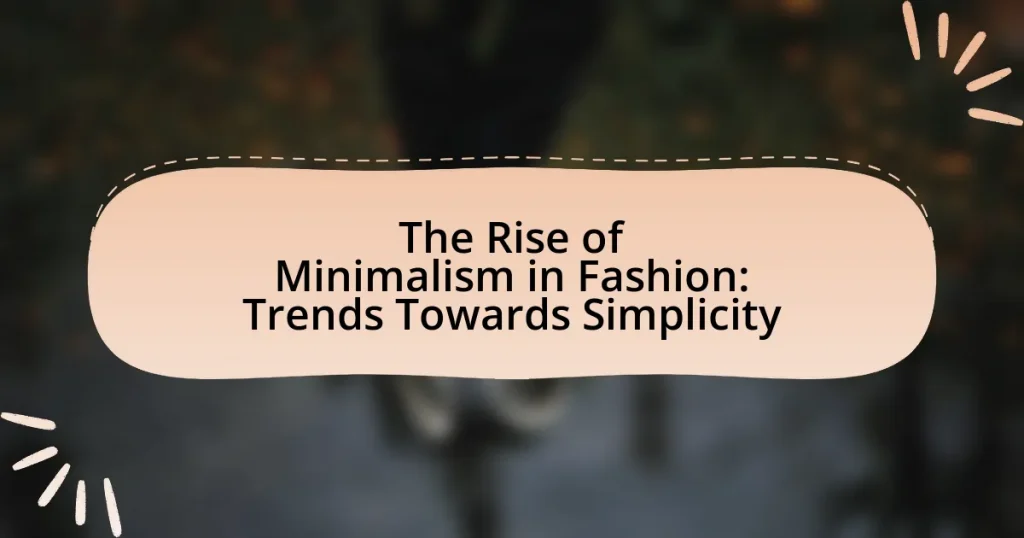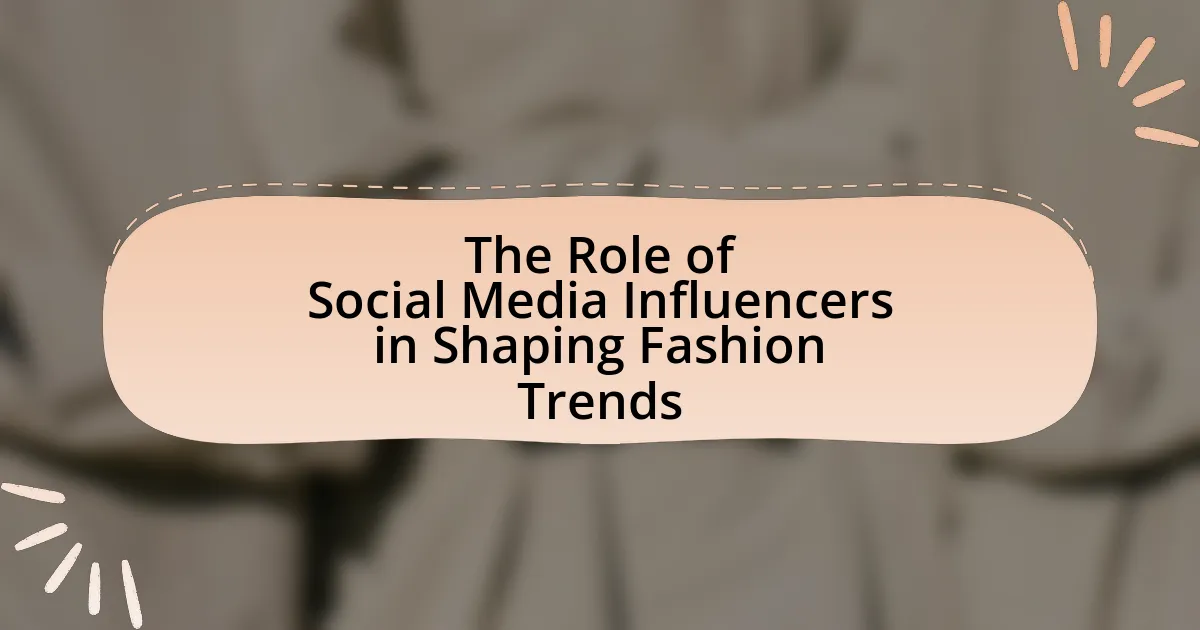The article examines the rise of minimalism in fashion, a design philosophy that emphasizes simplicity, clean lines, and essential elements. It explores the historical context of minimalism’s emergence in the late 20th century, influenced by cultural shifts and the desire for sustainability. Key characteristics of minimalist fashion, such as limited color palettes and high-quality materials, are discussed, along with the psychological factors driving consumer preferences for simplicity. The article also addresses current trends, notable brands, and the challenges faced by minimalism in a fast-fashion dominated market, while providing practical tips for individuals looking to adopt a minimalist wardrobe.
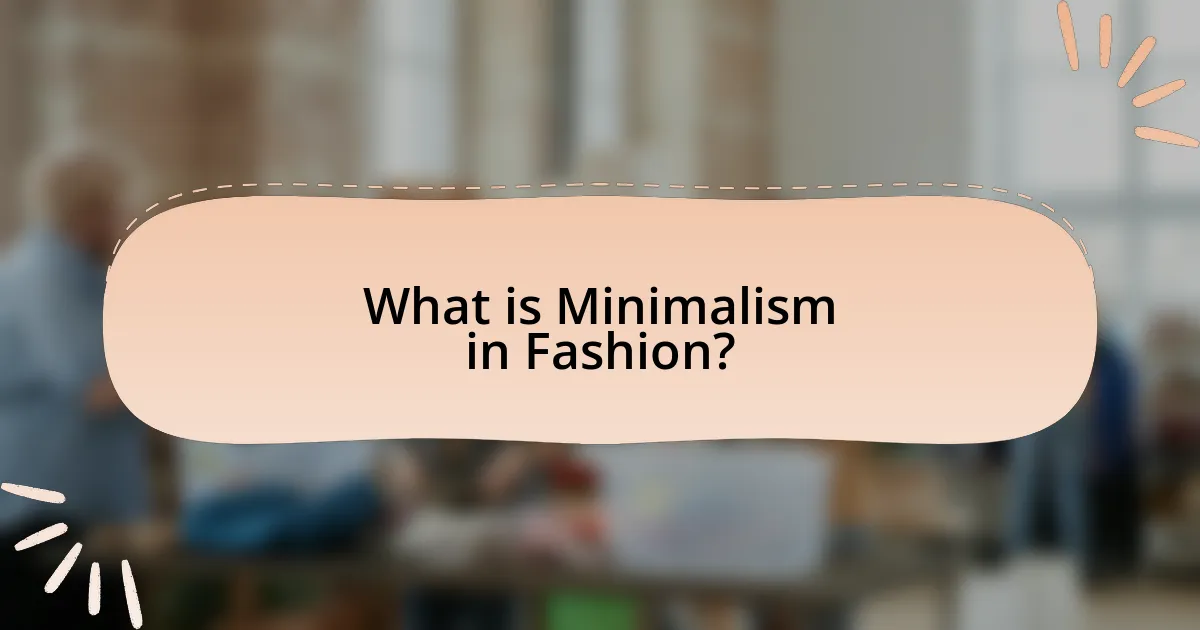
What is Minimalism in Fashion?
Minimalism in fashion is a design philosophy characterized by simplicity, clean lines, and a focus on essential elements. This approach emphasizes a limited color palette, streamlined silhouettes, and the elimination of excess ornamentation, allowing for versatility and timelessness in clothing. The minimalist movement gained prominence in the late 20th century, influenced by artists and designers who sought to strip away the unnecessary, as seen in the works of designers like Jil Sander and Calvin Klein. Minimalism promotes sustainability by encouraging consumers to invest in fewer, high-quality pieces rather than fast fashion, aligning with contemporary values of conscious consumption.
How did Minimalism emerge as a trend in the fashion industry?
Minimalism emerged as a trend in the fashion industry during the late 20th century, primarily influenced by the broader cultural movements advocating for simplicity and functionality. Designers like Jil Sander and Calvin Klein popularized minimalist aesthetics in the 1990s, focusing on clean lines, neutral colors, and a reduction of excess. This shift was a response to the over-the-top styles of the 1980s and reflected a growing consumer desire for practicality and timelessness in clothing. The minimalist trend gained further traction with the rise of sustainable fashion, as consumers increasingly sought versatile pieces that could be worn in multiple ways, aligning with minimalist principles.
What historical events influenced the rise of Minimalism in fashion?
The rise of Minimalism in fashion was significantly influenced by the cultural and economic shifts of the late 20th century, particularly the 1960s and 1970s. During this period, the counterculture movement and the rejection of excess materialism led to a preference for simplicity and functionality in design. The 1970s oil crisis also prompted a focus on sustainability and practicality, further encouraging minimalist aesthetics. Additionally, the emergence of influential designers like Calvin Klein and Jil Sander, who championed clean lines and understated elegance, solidified Minimalism as a prominent trend in fashion. These historical events collectively shaped a movement that prioritized simplicity over extravagance, reflecting broader societal changes.
How do cultural shifts contribute to the popularity of Minimalism?
Cultural shifts significantly contribute to the popularity of Minimalism by reflecting a collective desire for simplicity and intentional living in response to consumerism and environmental concerns. As societies increasingly prioritize sustainability and mental well-being, Minimalism emerges as a lifestyle that advocates for reduced consumption and decluttering, aligning with these values. For instance, studies show that 78% of millennials prefer experiences over material possessions, indicating a shift towards valuing quality of life over quantity of belongings. This cultural transformation fosters an environment where Minimalism is not only accepted but celebrated, as it resonates with the growing emphasis on mindfulness and simplicity in daily life.
Why is Minimalism appealing to modern consumers?
Minimalism is appealing to modern consumers because it promotes simplicity and intentionality in lifestyle choices. This appeal is driven by a growing desire to reduce clutter and distractions in an increasingly complex world, allowing individuals to focus on what truly matters to them. Research indicates that 78% of consumers feel overwhelmed by the amount of stuff they own, leading to a preference for minimalist designs that emphasize functionality and quality over quantity. Additionally, minimalism aligns with sustainable practices, as consumers increasingly seek to make environmentally conscious decisions, further enhancing its attractiveness in contemporary society.
What psychological factors drive the desire for simplicity in fashion?
The desire for simplicity in fashion is primarily driven by psychological factors such as the need for cognitive ease, emotional well-being, and social signaling. Cognitive ease refers to the human preference for simplicity, as it reduces mental effort and decision fatigue, allowing individuals to navigate their choices more efficiently. Emotional well-being is influenced by minimalism, as simpler styles often evoke feelings of calmness and clarity, aligning with the psychological concept of aesthetic pleasure. Additionally, social signaling plays a role; individuals may adopt minimalist fashion to convey sophistication and status, as simplicity is often associated with high-end brands and exclusivity. Research indicates that consumers are drawn to minimalist designs because they perceive them as more timeless and versatile, further reinforcing the psychological appeal of simplicity in fashion.
How does Minimalism align with contemporary lifestyle choices?
Minimalism aligns with contemporary lifestyle choices by promoting simplicity and intentionality in consumption and design. This alignment is evident as individuals increasingly prioritize experiences over material possessions, reflecting a shift towards sustainable living and mental well-being. Research indicates that 78% of millennials prefer to spend on experiences rather than things, highlighting a cultural trend that values minimalism. Furthermore, the minimalist aesthetic in fashion emphasizes clean lines and versatile pieces, catering to a desire for practicality and ease in daily life. This trend not only reduces clutter but also encourages mindful purchasing, resonating with the values of modern consumers who seek to simplify their lives.
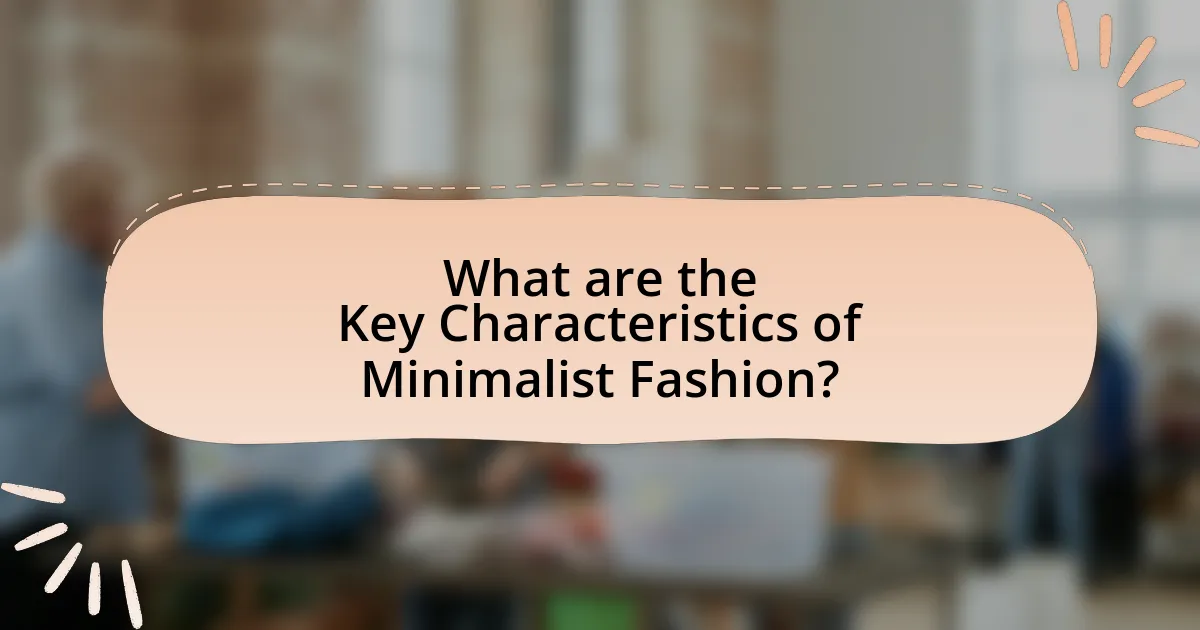
What are the Key Characteristics of Minimalist Fashion?
Minimalist fashion is characterized by simplicity, functionality, and a focus on essential pieces. This style emphasizes clean lines, neutral color palettes, and high-quality materials, often prioritizing timelessness over trends. The minimalist approach reduces clutter in both wardrobe and design, promoting versatility and ease of wear. For instance, a study by the Fashion Institute of Technology highlights that minimalist fashion often incorporates fewer, well-made garments that can be mixed and matched, thus encouraging sustainable consumption and reducing waste.
What design elements define Minimalist fashion?
Minimalist fashion is defined by clean lines, a limited color palette, and an emphasis on functionality. These design elements prioritize simplicity and elegance, often featuring geometric shapes and a lack of excessive embellishments. The focus on high-quality materials and craftsmanship further enhances the aesthetic, ensuring that each piece is both timeless and versatile. Minimalist fashion often draws inspiration from the Bauhaus movement, which advocated for the principle that form follows function, thereby reinforcing the idea that simplicity can convey sophistication.
How do color palettes and materials play a role in Minimalist designs?
Color palettes and materials are fundamental in Minimalist designs as they emphasize simplicity and functionality. Minimalist design typically utilizes a limited color palette, often featuring neutral tones like whites, blacks, and grays, which create a clean and uncluttered aesthetic. This choice of colors enhances the perception of space and light, aligning with the minimalist philosophy of reducing visual noise.
Materials in Minimalist designs are selected for their quality and texture rather than ornamentation. Natural materials such as wood, metal, and stone are commonly used, as they provide a sense of authenticity and connection to nature. The focus on high-quality materials ensures durability and longevity, which are key principles in Minimalism.
Research indicates that the use of a restrained color palette and high-quality materials can lead to increased emotional well-being, as these elements promote a sense of calm and order in the environment. This aligns with the broader trend of Minimalism in fashion, where simplicity is not just an aesthetic choice but also a lifestyle philosophy aimed at reducing excess and fostering mindfulness.
What types of silhouettes are commonly associated with Minimalism?
Common silhouettes associated with Minimalism include straight lines, boxy shapes, and A-line cuts. These silhouettes emphasize simplicity and functionality, often featuring clean, unembellished designs that focus on form rather than excessive detail. For instance, the use of tailored, structured garments in minimalist fashion highlights the importance of proportion and balance, which are key principles in minimalist aesthetics.
How does Minimalism influence fashion sustainability?
Minimalism influences fashion sustainability by promoting the reduction of excess consumption and encouraging the use of fewer, high-quality garments. This approach leads to a decrease in waste and resource use, as minimalist fashion emphasizes timeless designs and versatile pieces that can be worn in multiple ways. Studies indicate that minimalist practices can significantly lower the environmental impact of the fashion industry, which is responsible for 10% of global carbon emissions. By prioritizing quality over quantity, minimalism fosters a culture of mindful consumption, ultimately contributing to a more sustainable fashion ecosystem.
What practices in Minimalist fashion promote eco-friendliness?
Minimalist fashion promotes eco-friendliness through practices such as reducing consumption, prioritizing quality over quantity, and utilizing sustainable materials. By focusing on fewer, high-quality garments, consumers decrease the frequency of purchases, which in turn reduces waste and the environmental impact associated with fast fashion production. Additionally, minimalist brands often emphasize the use of organic, recycled, or ethically sourced materials, further minimizing their ecological footprint. For instance, a study by the Ellen MacArthur Foundation highlights that extending the life of clothing by just nine months can reduce carbon, water, and waste footprints by 20-30%.
How does Minimalism challenge fast fashion trends?
Minimalism challenges fast fashion trends by promoting a philosophy of intentional consumption and quality over quantity. This approach encourages consumers to prioritize fewer, well-made garments that offer longevity and versatility, contrasting sharply with the fast fashion model that emphasizes rapid production and disposable clothing. Research indicates that minimalism can reduce environmental impact; for instance, the Ellen MacArthur Foundation reports that the fashion industry is responsible for 10% of global carbon emissions, and minimalism advocates for a significant reduction in consumption to mitigate this issue. By fostering a mindset that values simplicity and sustainability, minimalism directly opposes the excessive and often wasteful nature of fast fashion.
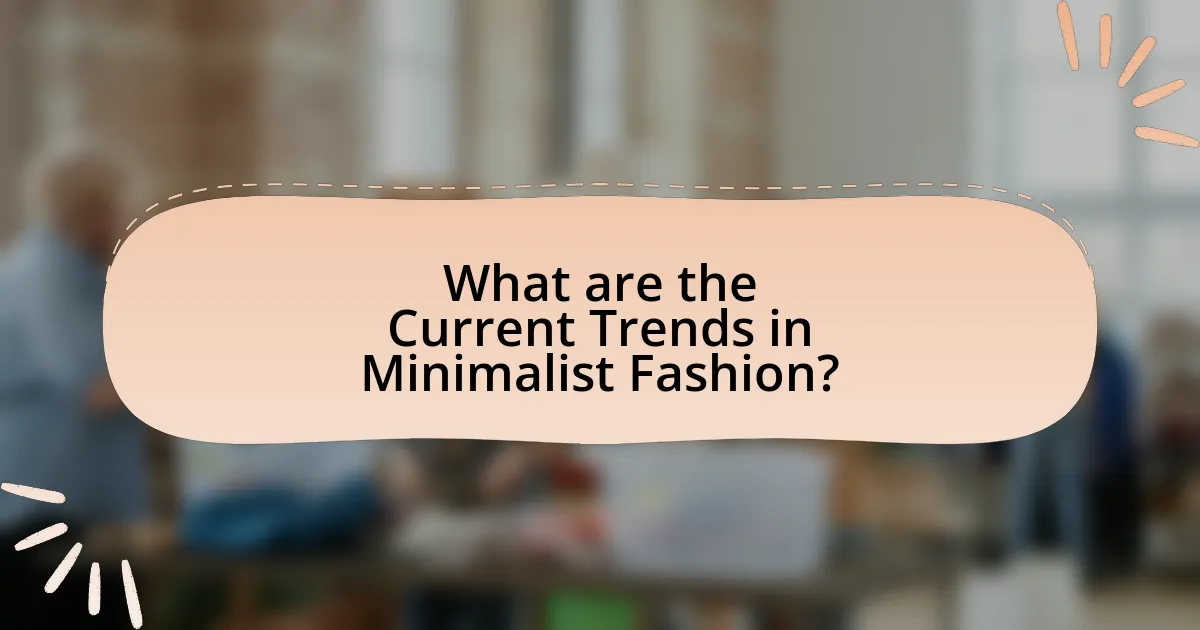
What are the Current Trends in Minimalist Fashion?
Current trends in minimalist fashion emphasize simplicity, functionality, and sustainability. Designers are focusing on clean lines, neutral color palettes, and versatile pieces that can be mixed and matched. The use of high-quality, sustainable materials is increasingly prevalent, reflecting a shift towards eco-conscious consumerism. Additionally, brands are adopting a “less is more” philosophy, promoting capsule wardrobes that prioritize timeless styles over fast fashion. This trend is supported by a growing consumer preference for ethical fashion choices, as evidenced by the rise in popularity of brands that prioritize transparency and sustainability in their production processes.
How are designers incorporating Minimalism into their collections today?
Designers are incorporating Minimalism into their collections today by focusing on clean lines, neutral color palettes, and functional silhouettes. This approach emphasizes simplicity and practicality, often utilizing high-quality materials to enhance the overall aesthetic. For instance, brands like COS and Everlane prioritize timeless designs that avoid excessive embellishments, aligning with the minimalist philosophy of “less is more.” Additionally, the trend is supported by consumer demand for sustainable fashion, as minimalist designs often promote longevity and versatility, reducing the need for fast fashion.
What are some notable brands leading the Minimalist fashion movement?
Notable brands leading the Minimalist fashion movement include Everlane, COS, and Muji. Everlane is recognized for its transparent pricing and commitment to ethical manufacturing, offering timeless basics that emphasize simplicity. COS, a brand under the H&M Group, focuses on modern, functional designs with clean lines and high-quality materials, embodying the minimalist aesthetic. Muji, originally a Japanese retailer, promotes a philosophy of simplicity and functionality in its clothing, emphasizing a no-brand approach that aligns with minimalist values. These brands exemplify the principles of minimalism through their design choices and business practices.
How do social media and influencers impact Minimalist fashion trends?
Social media and influencers significantly shape Minimalist fashion trends by promoting simplicity and intentionality in clothing choices. Platforms like Instagram and TikTok allow influencers to showcase minimalist outfits, emphasizing versatility and quality over quantity, which resonates with audiences seeking a more sustainable lifestyle. For instance, influencers often share capsule wardrobe ideas, demonstrating how a few key pieces can create multiple looks, thereby encouraging followers to adopt a minimalist approach. This visibility and accessibility of minimalist fashion on social media have led to a growing community that values minimalism, as evidenced by the increasing popularity of hashtags like #MinimalistFashion, which has garnered millions of posts, reflecting a collective shift towards simplicity in style.
What challenges does Minimalism face in the fashion industry?
Minimalism in the fashion industry faces challenges such as consumer demand for variety and fast fashion’s influence. The desire for constant newness drives consumers to seek diverse styles, which contradicts the minimalist ethos of simplicity and limited choices. Additionally, fast fashion brands produce high volumes of trendy items at low prices, making it difficult for minimalist brands to compete on price and accessibility. This results in a market where the principles of minimalism struggle to gain traction against the prevailing culture of consumption and rapid turnover in fashion.
How do consumer preferences affect the longevity of Minimalist trends?
Consumer preferences significantly influence the longevity of Minimalist trends by driving demand for simplicity and functionality in fashion. As consumers increasingly prioritize sustainability and practicality, brands that embrace Minimalism are more likely to thrive. For instance, a 2021 survey by McKinsey & Company found that 67% of consumers consider sustainability when making fashion purchases, indicating a shift towards minimalist designs that reduce waste and promote timelessness. This preference for essentialism over excess ensures that Minimalist trends remain relevant and enduring in the fashion industry.
What criticisms exist regarding the Minimalist fashion movement?
Criticisms of the Minimalist fashion movement include its potential to promote elitism and the oversimplification of personal expression. Critics argue that minimalist fashion often caters to a wealthy demographic, making it inaccessible to many consumers, as high-quality, minimalist pieces can be expensive. Additionally, some believe that the emphasis on simplicity can stifle individuality, leading to a homogenization of style where personal expression is sacrificed for conformity to minimalist ideals. This perspective is supported by discussions in fashion critiques that highlight how minimalism can inadvertently marginalize diverse fashion expressions and reinforce a narrow definition of aesthetic value.
What practical tips can help individuals embrace Minimalism in their wardrobe?
To embrace Minimalism in their wardrobe, individuals should start by decluttering their clothing items, keeping only those that are worn regularly and spark joy. This process can be guided by the “one in, one out” rule, which encourages replacing an item only when another is removed, thus maintaining a streamlined collection. Additionally, investing in versatile, high-quality pieces that can be mixed and matched enhances functionality while reducing the need for excess clothing. Research indicates that a minimalist wardrobe can lead to reduced decision fatigue and increased satisfaction with personal style, as noted in studies on consumer behavior and psychological well-being.
